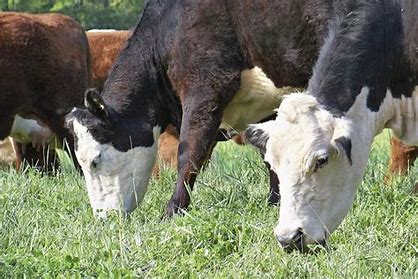

In order to achieve the desired high levels of welfare, farmers, stock persons and animal handlers should have at least a basic understanding of the behavior of the animals they work with. Knowledge of animals’ natural behavior is essential in ensuring we create an environment, manage and care for individual animals and herds in a manner that enables them to express themselves naturally and to remain healthy with a high quality of life. This is a fundamental aspect of livestock production.
More specifically, gaining an understanding of animal behavior allows farmers to more effectively identify and treat sick animals, respond to immediate challenges, select animals for breeding, design appropriate housing and to handle and herd without creating unnecessary stress.
Range cattle live in groups of cows and calves; males are often separated until breeding season. Dominance in cattle is based on age, sex, weight, presence of horns, and territoriality. Breed also seems to play a role, heavier dairy cattle are dominant to lighter breeds, while lighter beef cattle are dominant to heavier breeds. When a heavier and older cow is introduced into a group, it is usually subordinate to existing members of the group. In large herds, triangular relationships between cows exist. In dairy cattle, hierarchies change constantly as cows are added or removed from the herd. Once a hierarchy is established, overt aggression is reduced.
Very little is known about vocal communication of cattle; most commonly noted are the moo, call, hoot, and roar. A distressed cow or calf will call or hoot, an aggressive bull may roar, and a hungry calf will give a high-intensity “menh.”
Under natural conditions, cows cycle throughout the year, with peak activity between May and July and low activity between December and February. The heat cycle is usually 18–24 hr and generally begins in the evening. Common estrous behaviors include reduced food intake, increased movement, flehmen, standing behind another cow and resting the chin on its back, and increased licking and sniffing. Aggression and mounting also increase during the cycle. Heat detection is an important practice, especially in dairy cattle, in which artificial insemination is common. There are many methods to augment the detection of heat, including placement of dyes on cows’ backs that will stain the estrous cow’s ventral torso and pedometers that record increased movement. On some farms, a teaser bull is still in use. Bulls on pasture will graze alongside proestrous cows; the bull will stand head to head with the cow or may rest his head on her back. As estrus progresses he will try to mount, licking her vulva and showing flehmen.
Parturition normally occurs at night on pasture, and the calf normally starts suckling in less than 3 hr. The newborn calf spends most of its time near the dam until it is about 4–6 months old, when it forms unstable groups with other calves. Cows maintain bonds with their calves even when the next calf is born. On pasture, heifers are weaned when about 8 months old and bull calves when about 11 months old. Social status increases with age, and social relationships are not stable until at least 1 yr of age.
Understanding and observing the feeding behaviour of cattle can provide an early indication of sickness, and there are techniques and indicators to further enable this as a management tool especially for groups of animals.
The use of feed behavior e.g. frequency of calves drinking milk can be an indicator of illness but can also be dependent on whether the feed allowance is sufficient or not. Cows that develop severe metritis spend less time feeding and consume less feed compared with healthy cows and hence reduced time at the feeder can be used to identify dairy cows at risk for metritis.
Increased knowledge about social integration is necessary to develop effective management techniques that reduce the negative impacts of grouping animals together. When making a decision on the ideal group size to maximize welfare benefit, it is beneficial to consider the factors that influence group size in the wild.
Farming methods that take advantage of natural group sizes may be able to avoid some problems in social behaviour. However, through practical necessity, group sizes on commercial farms often need to be static, creating a situation of increased aggressive interactions affecting the welfare of some members of the group.
 Contact Jaguza Support
Contact Jaguza Support